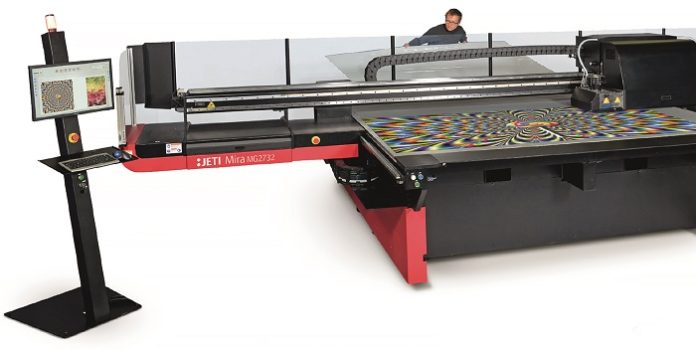Since drupa 2012, inkjet developments have continued apace, with the announcement of new inks and faster machines that include automation for material handling, streamline print-to-cut options and the advancement of LED curing. New chemistries include water-based UV-curable formulations, the challenge presented by latex chemistries and the ever present capabilities of aqueous-based, solvent-based and UV-curable options that continue to be used in everyday environments.
Not so many years ago the wide format printing market was still in an experimental stage and couldn’t be considered a serious contender for production in commercial environments. Since those early days the advances in technology have been rapid, now reaching the point where digital has become the preferred format for many display applications. Reliability in machine build has accompanied the continuing evolution of printheads and inks, resulting in platforms that produce consistent results that are fit-for-purpose; nowadays, it is rare to find a print business involved in large format jobs that doesn’t have an inkjet capability as part of its plant list of equipment.
Although there has been significant expansion of digital printing systems among display producers, screen-printing companies, sign-makers and, increasingly, the offset litho sector, this hasn’t seen the total demise of analogue production methodologies. Where wide format has scored, complemented by advances made in associative software and the materials available, is by bringing versatility and flexibility to all industry segments where the digital revolution has opened doors to low volumes, oneoffs, versioning and variable data. To these criteria can be added environmental benefits through a process that uses no traditional chemistry, plus a reduction in waste and the advantages of just-in-time and on-demand ordering by brands and end customers.
Practical benefits from digital production
From a practical perspective, wide format inkjet production carries the advantage of faster turnaround times, better operating environments, easier logistics, and more efficient end-to end workflows. Additionally, economic and stock reduction considerations have been factored into this mix and these have helped to bring inkjet processes to the fore.
During the past two decades, therefore, there has been a significant change in the way that applications coming under the remit of large or wide format are produced. This took digital print engines, typically ranging in size from 1 metre to 5 metres wide, from being speciality machines into the mainstream market. In that period of time, manufacturers have witnessed a metamorphosis in customer requirements, with today’s considerations in a print device becoming more diverse and eclectic in many environments.
Niche and speciality markets
While the growth in wide format print continues, it is noticeable that users of machines are not only servicing the more conventional market requirements but are also moving to new niche and speciality areas where digital technology can realize jobs that, formerly, were not feasible. The ability to experiment with inkjet and different materials is simplified because of fast-set-up and changeover, the ease of the prepress process and the viability of producing one-offs or very low volumes.
Additionally, print service providers face challenges not only from competition generated by their counterparts trading in the same market sector but also by new investors in digital technology. Those recent entrants that have opted to take on a niche or specialist segment, rather than merely become a ‘me too’ operation, avoid the inevitable race to win orders in an arena where rivalry can too often be based on price. Nonetheless, the growth in demand for wide format inkjet production devices continues across the entire digital spectrum with reasons driven by the desire for higher quality, faster throughput and the need for reliability.
Speed versus versatility
Is speed the essence throughout of today’s wide format printer users? The answer to this million dollar question differs depending on the business model and type of demand. Versatility is still key to the throughput benefits of inkjet and diversification can often prove to be the key factor that drives better margins and greater profitability. Ergo, effective workflow is as important as the throughput rates of a particular print device, and investment must be quantified against expected daily volumes, diversity and variability of work.
“We know many of our customers are using our printers to produce a wide variety of products on a range of substrates to meet the needs of their customers and to maximize ROI. So one printer can be used to produce everything from retail POS graphics, pop up banners and self-adhesive decals and labels to wall coverings, external displays and vehicle wraps,” says Richard Barrow, senior product manager, LFP signage, Epson Europe.
Mike Horsten, general manager marketing EMEA at Mimaki, concurs, “I believe that diversity in the offering is the key to success. For the most part, a single production type of print company no longer exists. Offering a diverse series of printing products is making the one-stop-shop a reality.”
Flexibility is not only governed by the creativity of the display producer or the sign shop. It is encouraged by technologies that have been developed to minimize downtime during job changeover and the ability to produce applications that are right first time. Every minute wasted when a machine sits idle eats into a company’s overall profitability, and present day device improvements certainly acknowledge these principles when it comes to functionality and performance.
End-to-end workflow advantages
Advances don’t lie only in the print engine’s design and construction; of increasing importance is the benefit of an efficient end-to-end workflow plus integration with onward services that aid accountability, such as streamlined finishing in print-to-cut environments, MIS/ERP and JDF compliance.
Vice president for Inkjet Solutions at EFI, Ken Hanulec confirms, “It is fairly obvious to calculate how a company can increase its throughput and its profits by printing more work on a wider, faster printer. But it is too easy for companies to overlook the ways they can also get better results with a better workflow. So it is definitely a way to gain a competitive edge that needs to be recognized.”
“If you are a large print house with multiple printers the workflow is crucial to survival. Without a good MIS system or an automated workflow the amount of work would kill any company in the long run. On the other hand, the demands for perfect workflow are not so important if you are a small company and you know your entire customer base,” says Mike Horsten of Mimaki.
With wide format print devices across all levels providing key output for an ever growing range of end applications, efficiency continues to increase in relevance. “Our support of workflow is the driving force behind efficiency of our printers,” insists Barrow. “We work closely with our software partners to ensure that the workflow to printer interface is very efficient.”
Getting it right first time
Agfa’s Paul Adriaensen endorses the relevance of good workflow in today’s print operations, “Good throughput means that the machine outputs correctly the first time and every time, job after job. Workflow automates input file and data processing, color management, printer and finishing settings in order to avoid delays during the entire production process.”
Today’s users of wide format printers can come from any background, whether they happen to be designers, former specialists in typesetting or repro, sign-makers, screen-printers or the sign-making sectors of the industry. The common feature among all is that every order should meet the quality of output required, produced to an acceptable price, on time. But every print service provider should look at the bottom line and not just production costs. Horsten emphasises, “There are still companies that don’t calculate the entire workflow cost before adding margin. If they can look at the whole cost structure of their business they would know the profitability for the work carried out.”
Growth in the wide format segment is down to many criteria, based on machine technologies and reliability, running costs, diversification in application type and balancing volume against the versatility of low numbers and oneoffs. But device flexibility is proving to be a key factor in future investment where fewer print engines can generate the right volumes across a broad range of materials and applications types.
“Diversity is one of the reasons customers like using our hybrid roll/flatbed printers. Many of our customers need to be able to print as many different types of jobs as possible, from corrugated displays printed to traditional banners to everything in-between,” says Hanulec of EFI.
Where wide format print will find its stronger markets that generate great profitability for its users is in applications away from the mainstream work. Indoor and outdoor displays, banners, point-ofpurchase, retail advertising, vehicle graphics and scaffold wraps continue to bring revenues to the supply chain that is established in this market segment but, often, at ever tighter margins. Growth areas, such as printed interior décor, are now generating a new interest in the capabilities of digital print with profitability often being driven by overall project management and creativity – areas where print becomes part of the modus operandi and not an isolated operation.
Compared with events that cater only for specific areas of the print industry, drupa 2016 extends its reach into all segments so that all areas of the graphic arts and beyond are presented with a strong snapshot of opportunities and the realization of trends. Connectivity between latter day cloud-based technologies, digital out of home (DOOH) functional applications and traditional production segments will show wide format technologies playing a cogent role in parallel as a complementary counterpart to alternative processes as well as playing its part in a standalone environment.


















